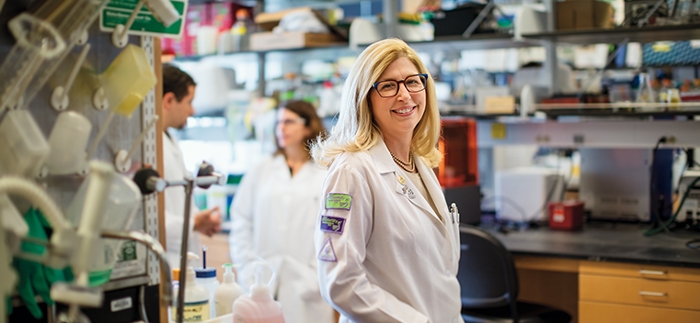Working to Preserve and Restore Fertility
IPR associate Teresa Woodruff achieves scientific firsts in the field of women’s health
Get all our news

IPR's Teresa Woodruff has developed a miniature female reproductive tract and a functional biosynthetic ovary.
Oncofertility specialist and IPR associate Teresa Woodruff is making great gains in the field of women’s reproductive health that could help preserve women’s fertility—and even restore the fertility of women affected by cancer.
Woodruff and her team at the Women’s Health Research Institute recently developed a miniature female reproductive tract, described in Nature Communications. The new 3-D technology—called EVATAR—is made with human tissue. It will enable scientists to test new drugs for safety and effectiveness on the female reproductive system, and it will also help researchers understand diseases of the female reproductive tract, including endometriosis, cancer, and infertility.
EVATAR, which resembles a small cube, contains 3-D models of ovaries, fallopian tubes, the uterus, cervix, vagina, and liver with special fluid pumping through all of them that performs the function of blood. The organ models are able to communicate with each other via secreted substances, including hormones, to closely resemble how they all work together in the body.
The ultimate goal is to use stem cells of an individual patient and create a personalized model of their reproductive system.
“This will help us develop individualized treatments and see how females may metabolize drugs differently from males,” said Woodruff, who also mounted a campaign that led the government to adopt a policy in January 2016 to account for gender in medical studies.
In another scientific first, Woodruff has developed a functional biosynthetic ovary. By removing a female mouse’s ovary and replacing it with a bioprosthetic ovary, constructed of 3-D printed scaffolds that house immature eggs, the mouse was able to not only ovulate but also give birth to healthy pups. The moms were even able to nurse their young.
“This research shows these bioprosthetic ovaries have long-term, durable function,” Woodruff said. “Using bioengineering, instead of transplanting from a cadaver, to create organ structures that function and restore the health of that tissue for that person, is the holy grail of bioengineering for regenerative medicine.”
Woodruff and her colleagues’ objective for developing the bioprosthetic ovaries was to help restore fertility and hormone production in women who have undergone adult cancer treatments or those who survived childhood cancer and now have increased risks of infertility and hormone-based developmental issues.
“What happens with some of our cancer patients is that their ovaries don’t function at a high enough level and they need to use hormone replacement therapies in order to trigger puberty,” said Monica Laronda, co-lead author of the study in Nature Communications and a former postdoctoral fellow in the Woodruff lab. “The purpose of this scaffold is to recapitulate how an ovary would function. We’re thinking big picture, meaning every stage of the girl’s life, so puberty through adulthood to a natural menopause.”
Teresa Woodruff is Thomas J. Watkins Memorial Professor of Obstetrics and Gynecology, director of the Women’s Health Research Institute, and an IPR associate.
This article has been edited from “Female Menstrual Cycle in a Dish” and “3-D Printed Ovaries Produce Healthy Offspring” by Northwestern News.
Published: June 26, 2017.